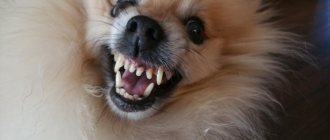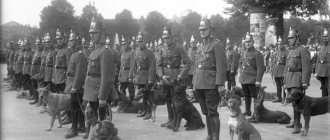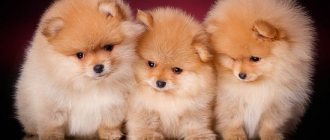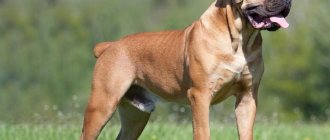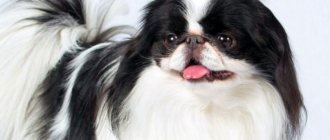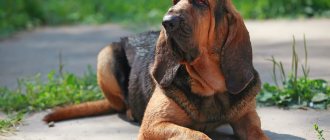History of the origin of the breed
The German Boxer breed has existed for more than two thousand years. Their ancestors were the now extinct baiting dogs - Bullenbeissers. Their name speaks for itself; translated from German it means “bull biter”. The dogs had powerful jaws with a pincer-like bite. This allowed them to breathe fully while clinging to their prey. Dogs were used in hunting big game: wild boars, deer, bears.
After the ban on the pickling method of extraction, the specialized breed lost its relevance. Its representatives began to be crossed with English bulldogs, and the resulting individuals were used by cattle breeders to protect their herds. Some dog experts believe that German shepherds also participated in the selection process.
The final prototype of the modern boxer was bred in 1850, 45 years later the first exhibition took place in Munich, the establishment of a German boxer fan club, with official recognition of the breed.
Why the new dog received such a name is not known exactly. According to the most common version, it is based on the dog’s ability to use its front paws in a fight. According to other assumptions, the name is based on the appearance of the animal, whose muzzle resembles a boxing glove.
Gradually, active, inquisitive dogs spread throughout the world. In 1950, an international club for boxers appeared - ATIBOX, which included representatives of several dozen countries. Today the breed is very popular in America, but is less common in Russia.
Features of the lifestyle
The German boxer's hyperactivity does not necessarily mean he is exposed to large areas. Dogs of this breed quickly adapt to any size apartment, although they like to sleep on a fairly spacious bed.
When choosing a place for your pet, it is important to take into account an important fact: boxers love to be constantly among people, so their house should not be located in a secluded corner.
It is worth thinking in advance about maintaining warmth around the dog, since the short hair of the Boxer is not able to protect him from the cold, so the animal must be protected from drafts and not walk outside for a long time at sub-zero temperatures. It's better to stock up on warm dog clothes.
Description of the breed with photos
The German Boxer gives the impression of a strong, hardy dog with well-developed, prominent muscles.
The breed standard stipulates the following characteristics:
- the body is square in shape, with strong bones;
- the head is quite large, but proportional to the body;
- the neck is strong, not too long;
- shortened muzzle with pronounced jowls;
- the eyes are dark and should not be bulging or sunken;
- the nose is large, pigmented black (dark brown is acceptable);
- The triangular ears are set high and close to the muzzle;
- a snack is required;
- limbs are straight, with developed muscles;
- The tail is straight and set high.
Please note: In some countries, ear and tail docking are prohibited by the 2002 German Boxer breed standard.
In addition to the officially recognized German breed variety, cynologists informally distinguish its American type. This includes the descendants of individuals who were transported overseas after the Second World War. They differ from the German ones in their more graceful physique and smaller head size. But these differences are noticeable only to experienced experts.
Indicators such as a head disproportionate to the body (too small or large), open teeth with a closed mouth, an unclear mask on the muzzle, and apathetic movements are recognized as a breed defect.
Size and weight
The German Boxer is a medium-sized dog. According to the standard, height at the withers is:
- 57-64 cm – for males;
- 53-63 cm – for females.
Females are more graceful, their weight rarely reaches 30 kg, ideally females weigh 25-27 kg. Males are more massive; for them, the permissible body weight is set at 27 - 35 kg.
Color and coat type
The coat of the German Boxer is thin, short, with a characteristic shine, and fits tightly to the body.
There are two officially recognized colors: red and brindle, within which many shades are acceptable (from pale yellow to brick brown).
The brindle color suggests the presence of dark, clearly drawn contrasting stripes on the main background. This coat color is the most common; it perfectly emphasizes the dog’s muscular structure.
White spots in a Boxer's color are acceptable, but they should not occupy more than 1/3 of the total surface area of the body. If this ratio is violated, the dog will be disqualified. Sometimes albino puppies are born in a litter, but they are recognized as a breed defect.
Interesting color
The coat of Boxer dogs is smooth and iridescent in the sun, short, dense and hard. There are two types of coat color:
- Ginger;
- Brindle.
The red coat color includes shades of light yellow, orange, red and brown. The most popular “golden mean” is a bright red color.
Boxers of another type have a tiger color: on light and red fur there are dark or black stripes along the ribs of the animal.
The stripes are noticeably different from the main color and have clear contours. Small white markings are also normal for the German breed.
Boxers of other colors - white, gray, black - are not actually representatives of the noble German breed.
Health and illness
Boxers are not known for their good health. The list of pathologies to which they are predisposed is very extensive. Hearing problems are common in this breed. According to statistics, from 20 to 40% of puppies are born completely or partially deaf.
Other breed-specific diseases include:
- allergy;
- aortic stenosis;
- brachiocephalic syndrome;
- bloating;
- hip dysplasia;
- cardiomyopathy;
- hypothyroidism;
- gastrointestinal pathologies;
- conjunctivitis;
- demodicosis;
- entropion of the eyelid;
- dermatitis (including allergic);
- deforming spondylosis.
Caution: Boxers are prone to developing malignant tumors.
The risks of developing pathologies can be minimized with the help of a well-designed diet and annual examinations by a veterinarian, which make it possible to timely identify and stop the development of “breed” diseases.
Lifespan
The average life expectancy of a boxer is short - about 10 years . But in recent years, experts have noted an increase in the number of individuals surviving up to fifteen years of age. This is due to the fact that breeders and veterinarians are actively working to improve the health of the breed.
Vaccination helps protect against deadly diseases. The first comprehensive vaccination (against distemper, parainfluenza, adenovirus, parvovirus enteritis, leptospirosis) is given to a Boxer puppy at the age of eight weeks. At 12-13 weeks, revaccination is carried out, and they are also vaccinated against rabies. The pet is then vaccinated annually. Before the procedure, the dog must be completely healthy; deworming must be carried out a couple of weeks before the procedure.
Defects and diseases
You can often notice in this breed:
- Congenital bobtail.
- Also visible defects of the testes. When deviating from the standards and from a healthy dog, you can see underdeveloped testes that have not descended completely into the scrotum.
- Take care that your dog does not get sick; there are often diseases that can develop into chronic diseases.
- Deafness, which can be congenital in a dog.
- There are representatives of this breed who have a deformed skull or jaw, which makes it difficult for them to breathe.
- High risk of heart disease, which often turns into cancer.
Character and intelligence
The German boxer has a stable psyche, an easy-going disposition, and a lively temperament. He loves all family members and is friendly and calm at home. The dog splashes out all its energy on walks. These dogs are very curious, they will happily go on a long journey, they will sniff every inch of the ground, looking for something interesting. At the same time, boxers do not run far from their owner. They love to spend time with their family.
Representatives of this breed are very cunning and good psychologists. They will instantly identify among the household members who will “give up the slack” - allow them to climb onto the bed or feed them the desired delicacies. Therefore, it is especially important to adhere to a single line of behavior when raising a pet.
Boxers do not tolerate loneliness well and need constant attention, games and entertainment. Psychologically, these dogs mature late, retaining puppy playfulness and spontaneity until about the age of three.
Attitude towards children and others
Despite their scary appearance, Boxers are very affectionate and kind dogs. They love children. They enjoy playing with them and will always defend the baby.
They are distrustful and wary of strangers, but behave with restraint. If they do not feel a threat to the owner in an outsider, then they will fully demonstrate their fighting character.
Boxers get along well with other pets living with them in the same apartment. But they can get into fights with other people’s dogs and chase cats in the yard. Early socialization of the animal helps to avoid destructive behavior of your pet in unfamiliar places.
Pros and cons of the breed
The German Boxer is a breed with its own strengths and weaknesses. To summarize, the following characteristics can be distinguished:
| pros | Minuses |
| Sociable, sociable; unpretentious in care; active; loyal, love the owner; excellent defenders; get along with children and other animals; available for purchase in many regions | They are prone to certain diseases; require adherence to a hypoallergenic diet; afraid of temperature changes; need training |
Boxers are sociable and sociable
The disadvantages are common to many breeds. Boxers have many more advantages, according to reviews from owners.
Owner reviews
- She learned the commands easily and happily shows me tricks with searching for objects. Many people are scared of boxers, but mine is completely harmless. Smart, emotional. Anna.
- I was afraid to get one, but... An unpretentious dog to care for. He goes swimming willingly and keeps order in the house. Difficulties with food - a beggar and knows no limits. He loves to sleep in bed with us and is very friendly with the child. Violet .
- My nephews and children literally ride the boxer. He endures steadfastly. But if someone provokes it, it won’t seem like much. He is jealous of dogs. Indifferent to the rest. He loves to play and needs a lot of walks. Get ready to run a lot. Sergey .
- As a child I was naughty and scared. I wanted to play. I've calmed down now. We go to training. Doesn't allow himself to bite. Have fun with children. Very smart, lively, loyal. He doesn't bark in vain. Aggression and noise are all from the wrong owners. Nina Nikolaevna .
Training and education
Boxer training begins at ten weeks of age. Dogs lend themselves well to training. They quickly remember commands and immediately understand what is required of them. The main thing is that the pet recognizes that the owner is a leader. The puppy must first be taught basic commands:
- "to me";
- "sit";
- "lie";
- "place";
- "it is forbidden";
- "ugh";
- "near".
It is important to remember that kids get tired quickly, lose concentration and interest in activities. Training should be kept short, but carried out several times a day.
The German Boxer is suitable as a first dog.
The difficulty lies in the “childishness” of these animals. They love to play around and must be trained firmly, but not cruelly. You cannot hit a boxer or shout at him. Such actions can disrupt the pet’s psyche. He will become aggressive or cowardly.
Classes must be regular and consistent. It is imperative to ensure that the command is carried out. Even if the dog is stubborn, classes should be stopped only after completing the task. It is better to conduct training in the form of a game, in different places. This will allow you to interest your pet and avoid stereotypical behavior.
You need to go to dog parks with a boxer so that the dog learns how to communicate correctly with its relatives and does not perceive them as rivals or prey. It is important to accustom your pet to traveling in public transport, being in crowded places, and other skills of living in society.
Photos and price of puppies
Those wishing to purchase a real German Boxer puppy should be prepared to spend about 30-50 thousand rubles.
Maintenance, care and nutrition
This breed of dog is absolutely not suitable for street keeping; its representatives must live in an apartment or house with people.
The German boxer does not tolerate both heat and cold. Extended exposure to the direct sun can cause the animal to suffer from heatstroke. In frosty or damp weather, your pet may catch a cold. In the autumn-winter period, you need to walk your dog in special overalls. If the apartment is cool, you may need “lounge” clothes.
The lounger should be placed away from drafts and heating radiators. The bedding should be soft and spacious so that the dog has the opportunity to stretch out. The place is selected in such a way that the pet can look around the entire room without leaving it - this way he will feel calm.
Before a puppy appears in the house, you need to ensure its safety: put electrical wires, poisonous plants, sharp and small objects out of reach. The Boxer is a very playful breed, so that the baby does not chew shoes and furniture, he needs to buy a lot of toys.
Boxers are easy to care for and practically do not shed. Short wool should be wiped weekly with a rubberized cloth, then with a suede cloth slightly moistened with water. You shouldn't bathe your dog often - this can cause skin diseases. It is recommended to wash your dog with shampoo no more than once every six months; it is better to purchase hypoallergenic products.
The boxer must also carry out the following procedures:
- After every walk, wash your paws, especially between the toes;
- Wipe the folds on the face with a damp cloth every day;
- Inspect the ears daily, and if necessary, wipe the shell with a napkin. If the skin on the cartilage turns red or there is an unpleasant odor, contact your veterinarian immediately;
- trim the claws as needed; they usually get worn down during walks;
- A boxer's teeth are brushed once a week using a special paste and brush. It is important to monitor the condition of the gums and prevent the formation of tartar;
- Wipe your eyes daily with a cotton pad soaked in warm boiled water.
Particular attention should be paid to the Boxer's nutrition, since he is prone to diseases of the gastrointestinal tract.
Those who decide to focus on industrial feed should choose products of the “super-premium” or “holistic” classes.
When feeding naturally, the diet should consist of products such as:
- lean meat (it should account for a third of all food per day);
- eggs (a couple of times a week);
- vegetables;
- dairy products;
- fruits;
- porridge.
Caution: Milk can cause digestive problems in an adult dog.
It is better to give food to puppies under 2 months of age in a ground form. Feed the meat raw or scalded with boiling water. The pieces must be hard enough for the jaws to fully develop. Boxers are allergic, new products (or food) should be added in small portions, and the pet’s condition should be carefully monitored.
Representatives of the breed are prone to gluttony, so it is important to control portion sizes and not allow the dog to take bites between feedings. Food from the master's table with spices and herbs is prohibited. You should not give your pet sweets, canned food, sausages, smoked meats, sweets, or baked goods. Even a small amount of these products can cause serious health problems for your dog.
The number of meals depends on the age of the pet. A puppy is fed four times a day for up to six months. From 6-12 months three meals a day are introduced. After a year, the dog eats twice a day. The dog should always have access to clean water.
Bitches usually have their first heat when they are about a year old. It is recommended to breed dogs after the third heat, when the dog’s body is ready for pregnancy and childbirth. During this period, it is important to provide the female with a nutritious diet, moderate physical activity, and time in the fresh air. Childbirth in Boxers usually proceeds without complications, but it is better if the puppies are born under the supervision of a specialist.
Conditions of detention
The Boxer is one of the most unpretentious dogs in terms of living conditions. Activity and size do not at all prevent such dogs from living in apartments of modest size. They behave quite calmly in the house; they wait for a walk before running.
Even before purchasing a puppy, you should consider several nuances:
- equip the place . It is better to choose a spacious lounger. Boxers sleep in a curl, but love to stretch after waking up and often play with toys in their corner. The soft bedding needs to be expanded as the dog grows. The “bed” must be removed from radiators and drafts. At the same time, the pet must constantly see its owners in its field of vision. Only in this case will he rest calmly, without unnecessary worries. Lack of control over what is happening makes boxers nervous;
- buy ammunition . A collar and leash will be required almost from the first weeks of life. Early training facilitates the process of socialization in the future;
- choose entertainment . Toys must be safe. Both a puppy and an adult dog can chew and swallow the “prey”. While the educational process is underway, it is better to put wires, shoes, and plants (especially poisonous ones) higher up. Balls, ropes, frisbees, rodents and the like will do;
- decide on the time and place of walks . The Boxer requires walks at least 2 times a day for 1 hour. Areas for active games will be required, since measured walking will not allow you to splash out energy and stretch numerous muscles.
The breed should absolutely not be kept outside. Short hair with zero undercoat does not help to keep warm in the cold. Such four-legged animals easily catch colds in drafts and high humidity, and in the open sun they easily overheat to the point of heatstroke. If you are free to roam on your property, you should ensure that your dog has constant access to the house. For the same reasons, it is better to reduce walks in too hot and cold weather.
A boxer on a chain will get bored
Boxers on chains languish from boredom, physical inactivity, and lack of communication.
On a note! You can help your pet in the cold with special dog clothing.
How to choose a puppy
Before buying a Boxer puppy, go to exhibitions, meet breeders, look at the parents of the future pet, evaluate their behavior. It is better if the selected dogs have already had several litters. In this case, you can track the fate of the offspring, talk with the owners, find out whether the pets have genetic diseases. It is advisable to take the baby to a new home at the age of two months.
A purebred Boxer puppy must meet the following characteristics:
- the bones are strong, but not angular;
- the skin on the body, head or muzzle does not sag;
- the body is not extended in length;
- the fur is shiny and clean;
- the back is flat, wide, without a hump;
- the tail is set high and does not curl over the back;
- limbs are strong, strong, parallel;
- despite the fact that the baby looks well-fed, his tummy should be toned;
- the head is proportional to the body;
- there is no discharge in the nose and eye area;
- noticeable undershot;
- the muzzle is wide, rectangular in shape;
- chin rounded in front, powerful;
- lips are dense, the upper one lies on the lower one, there are no sagging lips;
- the skull is angular but graceful;
- ears are high set, slightly turned forward, adjacent to the cheekbones;
- eyes are round, dark (in puppies a grayish tint is acceptable, it goes away with age) without a yellow tint;
- the look is curious, lively, but not malicious;
- the mask is clearly drawn and does not extend beyond the boundaries of the muzzle.
The room where animals are kept should look clean and free of dog smell. All puppies in the litter are approximately the same, inquisitive, active, and have no obvious physiological abnormalities or signs of dwarfism.
The breeder must have pedigrees for the dogs, veterinary passports, and evidence of the parents’ achievements at exhibitions (diplomas, cups, etc.).
If you have doubts about the ability to independently assess the advantages and disadvantages of your future pet, you should go with an expert to get a puppy. The cost of a boxer varies depending on the exhibition prospects in the future. A companion dog with a pedigree will cost from 15,000 rubles . The price of the future champion is from 30,000 rubles and above.
How much does a boxer cost?
Boxers are relatively inexpensive and can be purchased in almost any region of our country. You won’t have to look long for puppies of the “show” and “breeding” classes. You should treat your future purchase responsibly and thoroughly study the breed standard so that you don’t end up being deceived when making your own choice. Those who lack experience and knowledge are advised to seek advice from specialists.
The cost of a German boxer is influenced by factors such as conformation, age and origin. You can purchase a puppy from private breeders for 3,000 rubles. Only he will be without a pedigree: from the documents it will be possible to obtain only a veterinary passport.
Puppies from purebred parents, which have, in addition to a veterinary passport, a brand and a puppy card, are more expensive - from 8,000 rubles. Be sure to pay attention to the contents of these documents. The veterinary passport must contain notes on vaccinations and parasite prevention. Do not forget that all necessary vaccinations for a puppy are given between the ages of 2 and 3 months.
A puppy card is like a metric for a child; based on it, you will receive a pedigree for your pet in the future. Each such card contains the following data: date of birth, information about parents, which breeder it was purchased from, coat color, brand number and nickname. The mark is placed on the ear or groin area at the time of sale. A puppy card is a very serious document. Without a certificate of inspection of the puppies by the breeding commission, which includes authorized dog handlers, it cannot be issued.
Inexperienced owners are advised to be in close contact with the breeders and consult with them. Specialists who care about their job will never refuse advice and will try to help in solving possible problems with the puppy at the stage of their occurrence. This will help the boxer develop properly, learn to get along with his owners and explore the world. And how your pet will grow up depends only on you.
Owner reviews
For you, we have collected reviews from real owners of the German Boxer breed:
“Advantages: Very smart, kind breed, good with children. Disadvantages: Restless Skoda, requiring constant attention and physical activity.”
“I got my “German” from an old friend. The dog is wonderful, but very wayward. I think the reason for this is the lack of education in puppyhood. In general, Bill is a wonderful dog and a reliable watchman: he will let anyone into the house, lick him, play, but in life he will not let him out until I give the appropriate command. The only negative: at night he snores like a locomotive, sometimes you have to wake him up to make him quiet.”
“Despite my affection for boxers, I want to mention their shortcomings. First of all, it's drool. Secondly, short hair that sticks into the carpet like needles. I have to vacuum almost every day to keep the apartment clean. Thirdly, intolerance towards other people's dogs, especially large ones. Every now and then you need to look around to prevent a fight. Nevertheless, I recommend this breed to everyone!”
"Calm?! Yes, he’s just a devil from hell, not a dog... He’s constantly running around, freaking out, playing around, well, he’s definitely a clown. Sometimes you just want to strangle him. When I come home, at first I’m angry that the dog won’t even let me take off my shoes, but then I look into his little eyes and understand how he’s been waiting for me all this hard day.”
“The dog is just super, found on the street, running around without a collar. At first we were afraid to take two small children with us, but then we decided, it was a pity. Now he lives with us and we don’t regret it one bit, he’s a great dog!”
Kinds
Often the types mean “German” and “American” boxer. This is not entirely true. The American breed of Boxers emerged after World War II, when American soldiers brought Boxer puppies from Germany. The breed becomes so popular that for many years it was included in the top 10 AKC breeds, and at one time the most common in the United States.
It is difficult for an uninitiated person to notice the difference between these 2 dogs: Germans are heavier built and have larger heads than Americans.
But with all this, this is one breed, and mixed breeds between them are considered purebred puppies.
Varieties
The most popular varieties of the breed include:
- "Bogle" - with the participation of Beagle;
- “Bopay” – with the participation of Sharpei;
- “Boxerman” – with the participation of Doberman;
- “Boxweiler” – with the participation of Rottweiler;
- "Bullboxer" - a representative of the "incomprehensible" breed with the participation of the French Bulldog;
- “Bullbox” – with the participation of Pit Bull;
- “Bullbocker Staff” – with the participation of the Staffordshire Terrier;
There's also a basset hound here
Plus Mastiff
For the most part, mixed breeds of German boxers receive a characteristic color and an elongated muzzle.
Where to buy a puppy
- One of the most famous nurseries is Nikink-Var-Hard . It is named after the owners of the nursery. The kennel is registered in the Russian Canine Federation (FCI) and in the Russian Federation of Amateur Dog Breeding. The kennel has existed for more than 20 years, and the owners themselves have been breeding German boxers for about 30 years. It is located in St. Petersburg.
- Nursery "Ivanhoe". Began its activities in 1992. Boxers from this kennel are actively exhibited at exhibitions and are winners, and even the owners of other kennels are clients of the kennel. Located in Moscow.
How to choose a puppy: important tips for a future dog owner. Everyone needs to know this!

